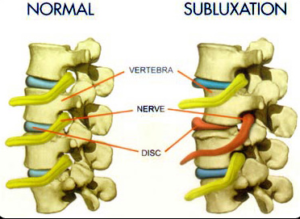Chiropractic is a medical profession that focuses on correction of the spine to decrease subluxations. A subluxation is a rotation of your vertebrae (the bones of your spine) that causes compression on a nerve root. There are three ways a nerve can become pinched in your spine. The bone can rotate and put pressure on the nerve, the disc can bulge or herniate and compress the nerve, and swelling of soft tissue can pinch on the nerve root. Of course we are ignoring more complex issues like cysts, tumors, spurring etc. All of these are taken into account also when you see a chiropractor. The good news is most back and neck pain tends to be musculoskeletal, which means it is one of the three (bone, disc, swelling) that is causing the pressure on the nerve.
When the bone subluxates it puts pressure on the disc with the twisting and pulling motion, since the disc is actually attached to the bone above and below. Yep, a “slipped disc” is actually impossible. It’s not a free floating washer in there, it’s actually a ligament that attaches the two bones together and provides shock absorption with the fluid inside.
This pressure and rotation from the subluxation then puts pressure on the nerve causing a cascade of muscle spasm, swelling and pain. Most patients present for the first time when they have pain, an obvious trigger to go see your doctor.
A chiropractor applies a gentle adjustment to the spine either with their hands or an instrument. The moves are gentle, effective and safe. This pushes the bone back into place and decreases the pressure on the nerve root. Then the cascade starts to reverse, decreasing muscle spasm and pain. It doesn’t happen right away after one adjustment. Can you take one antibiotic and heal an infection? Most patients see results within 5-7 adjustments. An adjustment will take about 15-20 minutes.
Dr. Myers is currently accepting new patients and we participate with all major insurances including Medicare and Medicaid. See you soon!!

Subluxation causing pressure on nerve, disc herniation and muscle spasm.
